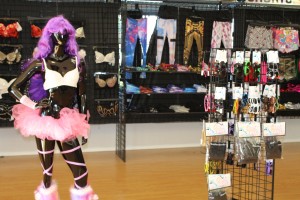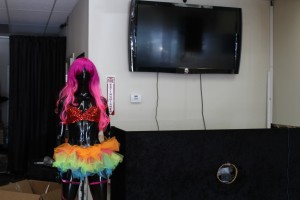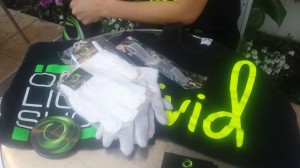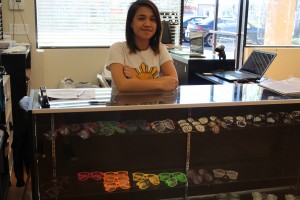[youtube]2h8uHxQCMXA[/youtube]

While the rave scene has been around since the late 1980s, in the past few years, electronic music festivals have soared in popularity. This modern era of the scene brings with it new cultural elements, such as the introduction of gloving. Light shows have always been a feature of electronic music festivals. While glow sticks were once used dominantly for light shows, gloving has become much more prevalent, both in music festivals and outside.
Origins and growth
Many trace the origins of gloving to a YouTube video created in 2006 by a glover called Hermes, who had put strobe lights into the tip of his gloves. The scene has grown quickly, and companies have emerged that cater to glovers, selling all sorts of LED lights and gloving accessories, as well as hosting weekly events for glovers to meet and exchange shows.
Participants wear white gloves with LED chips on the tip of their fingers. These chips can be programmed to have different colors and modes, making the possibilities endless. Glovers move their fingers to synchronize with the music in order to give a “show.” There are even names for common techniques, such as “tunnels” and “conjuring.”

Brian Lim founded EmazingLights after his girlfriend drove for nearly two hours to find a store that even sold gloves. At the time, gloves and gloving accessories were expensive and hard to find. Seeing there was demand to satisfy, Brian left his job as a technology consultant at Deloitte to open up the first EmazingLights store in 2010.
While the gloving scene originated in California and has two strong scenes in the Bay Area and Southern California, it has spread across the country. Lim said the huge demand for gloves has allowed for EmazingLights to expand to four stores, with its most recent opening in Texas. Lim also said that EmazingLights would have a pop-up store at Ultra Music Festival.
Outside of music festivals
While glowsticking, for the most part, has typically been limited to events, gloving has found its own domain outside of festival venues. There is even a student group called Ambience that has chapters across various universities dedicated to gloving.
“Anybody can glove,” says Sam Trinh, a member of UC San Diego’s Ambience. “You don’t have to go to shows to glove. I’ve seen kids as young as twelve and people in their late twenties at meetups.”

A big blow to the gloving scene occurred in 2011, when Insomniac Events, one of the largest electronic music festival organizers, banned LED lights from their events. “This came during a time when they were under intense scrutiny,” explained Lim. During EDC 2010, a 15-year old festivalgoer had died from an overdose at the events.
On Facebook, Insomniac Events explained: “Although there are many who use these lights as an art form, the image that it creates when groups of music fans are sitting or lying on the floor gazing at the designs reflects poorly and sends a false message of what the electronic dance music scene is about. This image jeopardizes our ability to produce events.” However, Lim mentioned that EmazingLights and Insomniac are in current discussions about the use of LED lights at their shows.
Regardless, a large community has formed around the subculture of gloving. “If anything, the ban has helped gloving establish itself as an art form outside of events,” said Lim.
EmazingLights holds weekly events in its stores that draw in glovers from all over the area. Some even drive as long as two hours to attend the event. It is during these meetups that glovers exchange or “trade” shows to discover new techniques and different styles.

To testify to the seriousness that participants attach to gloving, there are competitions where glovers come together to compete with one another for ranking, money and prizes. EmazingLights and Orbit Light Show also sponsor their own teams to send to competitions and music festivals.
“A lot about being sponsored is the pride that you get as well as the name,” said Vinh Bui, a member of Vivid, a team sponsored by Orbit Light Show. When asked when he would stop, he replies, “I’m sure I’ll stop one day, but for now it’s hard to see that end. It’s a growing scene and being part of Vivid is like having another family.”
Where are the ladies?
While there is the common belief that “anyone can glove,” the gloving scene is still dominated by males. Glover Rosemary “Kat” Lloret also believes that women glovers are underrepresented. “There’s definitely a lot more males in the gloving community,” said Lloret, who has been gloving since 2009. “Guys got into gloving first, and the girls didn’t really pick it up until later, but when a few girls started gloving, other girls got into it, too. I mean, we can do what the boys can do.”

Lim also said that EmazingLights is doing more to support females who choose to glove. “We want to encourage more girls to pick up gloving. For example, we have hashtags like ‘GirlsWhoGlove’ where girls can post gloving pictures, and we also sponsor all-girl gloving teams.”
But Lim believes that gloving can be daunting to start. “However, there’s a lot of resources out there, like videos and tutorials, so girls can learn how to glove on their own.”
